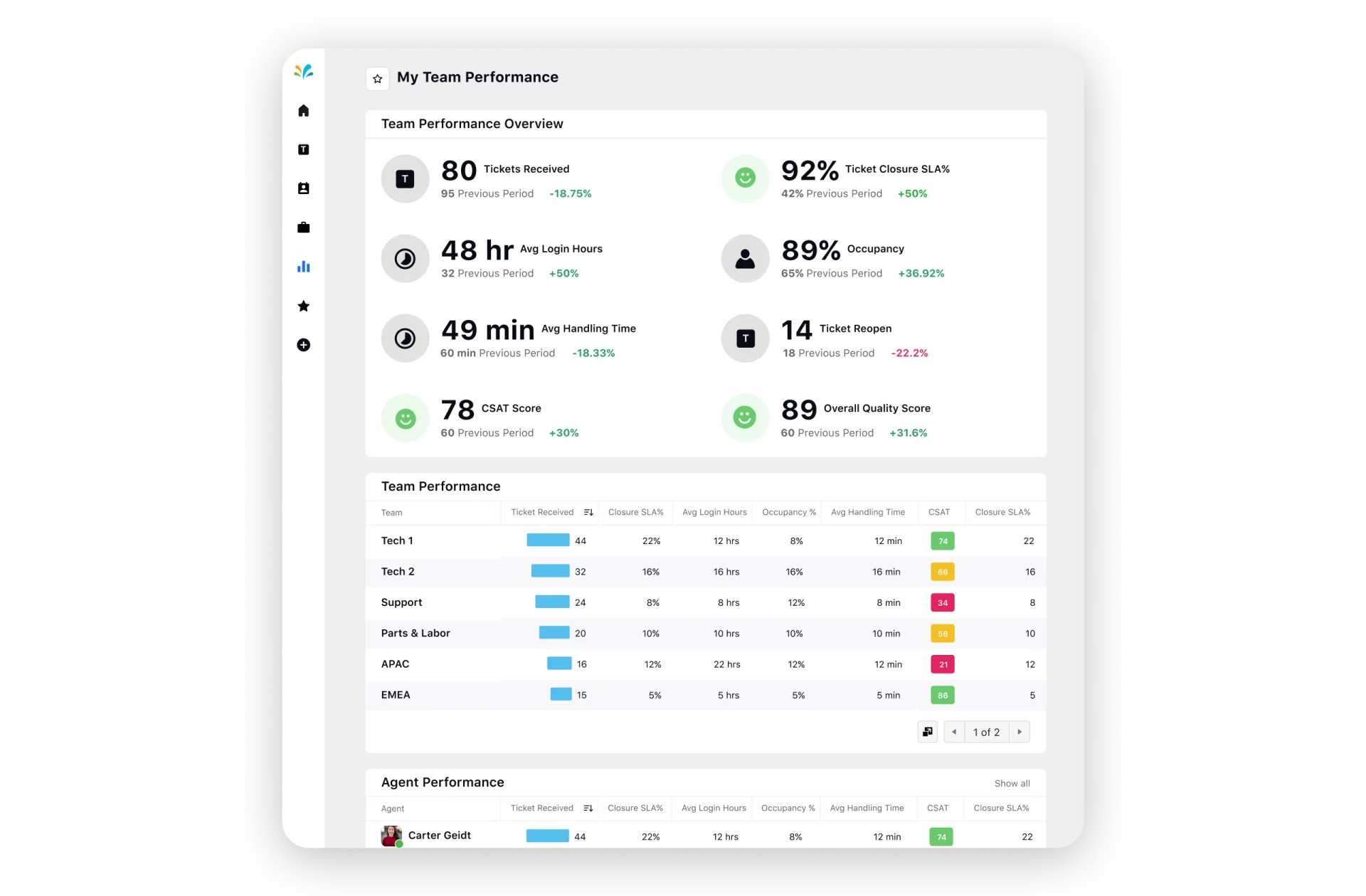- What is a service level agreement (SLA)?
- SLA vs. SLO vs. SLI
- Top business benefits of service level agreements
- How to create service level agreements
- Key service level agreement components
- What is the indemnification clause in an SLA?
- 6 Types of SLAs for organizations
- What happens when there is an SLA breach?
- Use cases for integrating SLAs in customer service
What is a service level agreement (SLA)?
A service level agreement (SLA) is a contractual agreement between a service provider and a customer, outlining the level of service the provider will deliver. In customer service, it establishes measurable criteria for performance, such as response times, availability and quality standards.
For instance, a cloud contact center might commit to ensuring 99.99% uptime or providing support responses within 12 hours, exemplifying the practical application of SLAs in elevating customer experience.
SLAs are widely used across industries, including technology, telecommunications and outsourcing. These agreements typically detail the services provided, performance metrics, responsibilities of both parties, procedures for issue resolution and any penalties or remedies for failing to meet the agreed-upon standards.
Ultimately, SLAs are crucial for fostering transparency, trust and effective communication between service providers and their customers.
SLA vs. SLO vs. SLI
Simply put, a service level agreement (SLA) encompasses various service level objectives (SLOs), specific, measurable goals or targets set to ensure the delivery of satisfactory services. These objectives are quantified and tracked using service level indicators (SLIs), which are specific metrics used to measure the performance of a service. Here is how these differ from each other.
Aspect | SLA | SLO | SLI |
Definition | A formal agreement between service provider and customer, outlining agreed-upon levels of service delivery | Specific, measurable goals for service performance that support SLA attainment | Quantifiable metrics used to measure the performance of a service |
Purpose | Establishes the overall service level to be provided, including measurable criteria for performance | Sets internal targets aligned with SLA requirements to ensure service quality | Monitors and tracks the performance of a service against predefined standards |
Focus | External, customer-facing commitment | Internal performance objectives | Technical metrics for service monitoring |
Accountability | Both the service provider and customer are held accountable for meeting SLA terms | Internal teams and processes are responsible for meeting SLOs | Technical teams and monitoring systems track and analyze SLIs |
Examples | - Guaranteed response times | - Achieving 99.9% availability | - Response time metrics |
Top business benefits of service level agreements
Service level agreements (SLAs) in customer service set minimum service quality expectations, providing clarity for both customers and service providers. Here are some key benefits:
Enhanced customer experience: SLAs ensure consistent service delivery, instilling customer trust and confidence even during challenging situations. Meeting SLA standards leads to higher levels of customer satisfaction and loyalty.
Seamless collaboration: With SLAs, all stakeholders can access the same information and commitments, facilitating alignment and reducing conflicts in service delivery processes.
Effective communication: By clearly defining communication protocols, SLAs enable swift resolution of issues through predefined customer service channels during crises. This not only keeps the expectations straight but also saves time and resources with coherent and efficient problem-solving.
Improved efficiency: Clear service guidelines provided by SLAs streamline resolution processes, allowing service providers to prioritize tasks and deliver timely solutions. This optimized efficiency reinforces customer trust and strengthens the overall service experience.
Risk mitigation: By establishing clear expectations and responsibilities, SLA helps identify potential issues early on, allowing for prompt resolution and reducing the likelihood of larger problems arising. Moreover, since SLAs outline consequences and penalties for violation of terms and conditions, this ensures that vendors are incentivized to deliver the highest level of service consistently.
How to create service level agreements
Crafting effective service level agreements (SLAs) can be daunting, as they require careful consideration and planning. However, the key to success lies in creating SLAs that are clear, concise and easy to implement while meeting the needs of both the service provider and the customer.
Moreover, gaining approval from all stakeholders is crucial for ensuring buy-in and commitment to the agreed-upon terms. To illustrate, let's explore the process of writing SLAs for a fictional SaaS company, highlighting key steps and considerations.
Step 1: Define your needs and goals
Identify stakeholders: Determine all parties involved in the SLA process, including the service provider, IT operation teams and customer support teams. Understanding the roles and responsibilities of each stakeholder ensures comprehensive SLA coverage and effective collaboration.
Clarify service scope: Clearly define the services covered by the SLA. This may include website uptime, software maintenance and customer support. Defining service scope upfront helps manage expectations and ensures service provider and customer alignment.
Set business objectives: Establish specific, measurable customer service objectives aligned with organizational goals. For a SaaS company, common objectives include achieving high uptime (e.g., 99.95%), fast incident resolution (e.g., under 4 hours) and minimal data loss. Clearly defined objectives provide a framework for measuring SLA performance and driving continuous improvement efforts.
Step 2: Establish performance metrics
Determine the specific metrics that will be used to measure the performance of each service, such as response times, availability and error rates. After discussing with relevant stakeholders, set realistic targets for each metric based on industry standards and customer expectations.
Example:
Uptime SLA: Set a target of 99.95% uptime, measured by third-party monitoring tools.
Support response time SLA: Establish a target of 30 minutes for response time, tracked through ticketing systems.
Issue resolution SLA: Aim for a resolution rate of 90% within 24 hours, measured by closing tickets with customer satisfaction ratings.
Step 3: Outline responsibilities and escalation procedures
Specify service provider obligations: Clearly define the service provider's obligations, detailing what services will be delivered and how they will be provided. This may include maintenance frequency, security protocols, support availability and other relevant commitments.
Define customer responsibilities: Establish clear customer expectations and limitations, outlining their responsibilities in the service delivery process. This may include requirements such as timely reporting of issues, providing necessary information for troubleshooting and adhering to security protocols.
Document escalation procedures: When service standards are not met, it is important to have escalation management in place to ensure that issues are addressed and resolved in a timely manner. In such situations, you need to define the steps to follow when issues cannot be resolved within agreed-upon timeframes. This includes identifying the escalation matrix, responsible parties and communication protocols. Read how to tackle escalation
Go Beyond Escalations: Learn About End-to-End Complaint Management
Step 4: Draft and review the agreement
At this stage, there is a higher risk of making mistakes. The amount and complexity of information can be overwhelming, so it's crucial to organize the document correctly.
Ensure that introductions, service descriptions, metrics, responsibilities and escalation procedures are included and presented clearly and straightforwardly, avoiding technical terms and acronyms. It's essential to ensure that all parties understand the terms, provide feedback and address any concerns before creating the final version.
Step 5: Monitor and evaluate performance
Implement monitoring systems to track performance metrics in real time and evaluate performance against SLA targets. Use this data to identify areas for improvement and make necessary adjustments to the SLA as needed.

Must Read: Calculating Call Center Service Level – A Detailed Guide
Key service level agreement components
SLAs hold great importance within outsourcing contracts, serving as the central framework for monitoring service delivery throughout the duration of the service agreement. Imperfections in drafting SLAs can yield substantial repercussions, leading to discrepancies between reported service delivery metrics and the actual performance on the ground. On this note, explore the key components commonly found in a standard SLA document:
Component | Description |
📄Service description | Defines the services provided, including scope, limitations and any exclusions. |
✅Service metrics | Highlights specific metrics for measuring performance, such as response times, uptime and resolution times. |
🎯Service level targets | Reflects each service metric, specifying acceptable levels of performance. |
💼Responsibilities | Outlines service provider and customer responsibilities for monitoring, reporting and resolving issues. |
🔝Escalation procedures | Establishes procedures for escalating unresolved issues, including contacts and escalation paths. |
📊Performance reporting | Defines how performance will be measured, reported and communicated to stakeholders. |
💰Penalties and remedies | Specifies penalties or remedies for failure to meet SLA targets and incentives for exceeding targets. |
📝Review and amendment | Includes provisions for regular review and amendment of the SLA to ensure relevance and effectiveness. |
🔒Termination clause | Outlines conditions for termination, including notice periods and associated penalties or obligations. |
🏢Legal and compliance | Ensures whether SLA complies with relevant legal and regulatory requirements, including data protection and privacy laws. |
What is the indemnification clause in an SLA?
An indemnification clause in a service level agreement (SLA) is a contractual provision that delineates the responsibilities and liabilities of the parties involved regarding legal claims, damages, losses or liabilities arising from the services provided.
In a nutshell, the indemnification clause serves to allocate risks and liabilities between the service provider and the customer, ensuring fairness and accountability. It provides financial protection to customers in the event of service provider failures while also limiting the liability of service providers and encouraging effective risk management practices.
The indemnification clause typically defines specific situations in which indemnification applies. Common examples include:
Breach of contract: If the service provider fails to meet agreed-upon service levels, they may be liable for damages caused to the customer.
Negligence: If the service provider's negligence results in losses for the customer, the indemnification clause may require them to compensate.
Third-Party claims: If a third party makes a claim against the customer due to the service provider's actions, the indemnification clause may specify who is responsible for covering the costs, thereby protecting the customer from financial repercussions.
6 Types of SLAs for organizations
Customer-based SLA Tailored to specific customer requirements, this type of SLA is customized to meet individual customers' or client groups' needs and expectations. It allows you to provide personalized service levels and address unique preferences. | Service-based SLA Service-based SLA focuses on specific services or service categories and defines the agreed-upon levels of performance for services. It enables you to prioritize resources and efforts based on the criticality of each service. | Multi-level SLA It is designed to address the diverse needs of different customer segments; this type of SLA allows organizations to offer differentiated levels of service based on customer value or importance. |
| | |
What happens when there is an SLA breach?
Often, the last thing customer service managers want to hear when an SLA breach occurs is that the affected party promptly notifies the other, initiating an investigation to determine the cause of the breach. A remediation plan is then devised and implemented to address the breach and prevent future occurrences. Depending on the SLA terms, the breaching party may provide compensation or face penalties.
Unresolved breaches may be escalated following outlined procedures. Both parties engage in continuous improvement efforts to strengthen processes and prevent future breaches, emphasizing effective communication, collaboration and proactive problem-solving throughout.
Example: Oracle cloud infrastructure clearly highlights if they fail to meet the service commitment by factors other than those used in their SLA, then Oracle may issue service credits for the applicable cloud service. Below is a snapshot of Oracle cloud infrastructure service credits for the applicable non-compliant service.

💡Sprinklr Pro Tip
Businesses have diverse strengths, and with Sprinklr, you can easily customize SLA conditions for tickets from different channels like social, voice, live chat and email and meet customer expectations across all channels.

Use cases for integrating SLAs in customer service
Integrating service level agreements (SLAs) within your customer service operations, particularly within your contact centers, yields significant benefits in enhancing overall service quality and customer satisfaction. Here are some use cases for integrating SLAs in customer service through your existing contact centers:
Priority handling of critical inquiries
Contact centers can prioritize the handling of critical inquiries, such as urgent technical issues or account discrepancies, by defining SLAs that mandate shorter response and resolution times for such cases. This helps you bring attention swiftly to high-priority matters, mitigating potential business disruptions and bolstering customer trust.
Consistent service delivery across channels
By incorporating SLAs into contact center operations, you can ensure consistent service delivery across various customer service channels, including phone, email, live chat and social media. Standardized SLAs for response times, issue resolution and service availability help you maintain uniform service quality levels, regardless of the communication channel chosen by your customers.
Transparent communication and escalation procedures
SLAs facilitate transparent communication and clearly define escalation within contact centers. Your contact center agents can effectively communicate service commitments, expected resolution timelines and escalation paths to customers, fostering transparency and trust.
Enhanced customer satisfaction and retention
Integrating SLAs in customer service directly impacts customer satisfaction and customer retention. Meeting or exceeding SLA targets demonstrates a commitment to delivering exceptional service experiences, which in turn builds customer loyalty and encourages repeat business.
Performance monitoring and continuous improvement
Your contact center can leverage SLAs to monitor service performance metrics systematically and drive continuous improvement initiatives. By tracking key customer service metrics, such as average handle time, first contact resolution and customer satisfaction scores, you can identify areas for optimization and implement targeted improvements to enhance overall service efficiency.
Good to know: Advanced analytics and reporting software from Sprinklr offers a centralized dashboard that assists customer service administrators in accessing vital metrics related to SLA policies. These metrics include fulfillment time and instances of SLA breaches, along with a variety of other customer service metrics like average handle time, CSAT score, quality score and more.

💡A few hand-picked SLAs to take inspiration from:
Sprinklr's SLA stands out for its clarity and organization, categorizing support packages and detailing issue definitions, resolution times and service particulars. Notably, Sprinklr sets new standards of transparency by clearly presenting scheduled maintenance windows and minimizing customer impact through strategic operations, all meticulously outlined in their SLA document.
Stripe's SLA impresses with its meticulous attention to detail, particularly in addressing beta features. The document advises customers against using beta services in production environments unless they fully understand and accept the associated limitations and flaws. This proactive approach ensures transparency and risk awareness for users.
Vimeo
As a streaming service giant, Vimeo's SLA shines in its commitment to uptime and customer satisfaction. The company clearly outlines credit percentages in case of uptime commitment breaches in a calendar month, along with detailed explanations of credit limits and technicalities surrounding uptime commitment. This demonstrates Vimeo's dedication to service reliability and accountability.
The journey of Estafeta Mexicana with Sprinklr exemplifies the transformative power of integrated customer experience management. Facing the challenge of meeting heightened customer expectations with a lean team, Estafeta leveraged Sprinklr's Unified Customer Experience Management (Unified-CXM) to unify digital channels, automate support processes and gain valuable insights for improved SLA performance. The results speak for themselves: a 60% improvement in customer support SLAs, enhanced brand monitoring accuracy and streamlined digital marketing operations.
As businesses worldwide navigate the complexities of digital engagement, Sprinklr Service empowers you to overcome obstacles, deliver exceptional customer experiences and thrive in an ever-evolving marketplace. Watch Sprinklr Service in action through a personalized demonstration.
Frequently Asked Questions
related products
Thank you for contacting us.
A Sprinklr representative will be in touch with you shortly.
Contact us today, and we'll create a customized proposal that addresses your unique business needs.
Request a Demo
Welcome Back,
No need to fill out any forms — you're all set.


